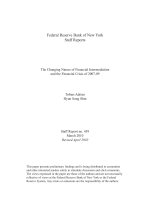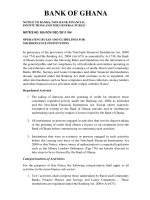financial crises and the subprime meltdown
Bạn đang xem bản rút gọn của tài liệu. Xem và tải ngay bản đầy đủ của tài liệu tại đây (199.56 KB, 22 trang )
Copyright 2011
Pearson Canada Inc.
9 - 1
Chapter 9
Financial Crises and the
Subprime Meltdown
Copyright 2011
Pearson Canada Inc.
9 - 2
Factors Causing Financial Crises
•
Well-working financial system solves
asymmetric information problems
•
Financial crises occurs when increases in
asymmetric information causes severe adverse
selection and moral hazard problems.
•
Results in financial markets inability to channel
funds efficiently
Copyright 2011
Pearson Canada Inc.
9 - 3
Asset Market Effects on Balance Sheets I
•
Stock market Decline
–
Leads to lower net worth and lenders are more unwilling
to lend funds.
–
Leads to a decline in investment and aggregate demand
•
Unanticipated Decline in the Price Level
–
Debt contracts have fixed (nominal) interest rates with
long maturity.
–
Unanticipated decline in price level leads to high real
liabilities which decreases net worth and increases
problems of adverse selection and moral hazard
–
Lead to lower lending, lower investment and lower
aggregate demand
Copyright 2011
Pearson Canada Inc.
9 - 4
Asset Market Effects on Balance Sheets II
•
Unanticipated Decline in the Value of Domestic
Currency
–
Debt contracts denominated in foreign currency
–
When foreign currency’s value decreases, the domestic
debt burden increases
–
Deterioration of balance sheet and decline in net worth
–
Increase adverse selection and moral hazard
–
Leads to a decline in investment and aggregate demand
•
Asset Write-Downs
–
Decline in asset prices lead to write-owns on value of
assets which also impacts lending.
Copyright 2011
Pearson Canada Inc.
9 - 5
Deterioration in Financial Institutions’ Balance
Sheets
•
Banking Crisis
•
Increases in Uncertainty
•
Increases in Interest Rates
•
Government Fiscal Imbalances
Copyright 2011
Pearson Canada Inc.
9 - 6
Dynamics of Past Canadian Financial Crises:
Stage I
Stage One: Initiation of Financial Crisis
•
Mismanagement of Financial Liberalization and
Innovation
–
Credit boom
–
Deleveraging
•
Asset Price Boom and Bust
–
Asset-price bubble
•
Spikes in Interest Rates
•
Increase in Uncertainty
Copyright 2011
Pearson Canada Inc.
9 - 7
Dynamics of Past Canadian Financial Crises:
Stage 2
•
Worsening business conditions and uncertainty
leads depositors to withdraw their funds.
•
Decreases the number of banks and worsens
both adverse selection and moral hazard
problems in the credit markets.
•
Further spiralling down of the economy.
Copyright 2011
Pearson Canada Inc.
9 - 8
Dynamics of Past Canadian Financial
Crises: Stage 3
•
Economic downturn lead to sharp decline in prices
–
Debt deflation
•
Substantial unanticipated decline in the prices level
lead to further deterioration in firms net worth
•
This increases adverse selection and moral hazard
problems.
•
Investment spending and aggregate demand activity
are depressed.
Copyright 2011
Pearson Canada Inc.
9 - 9
Sequence of Events in the Canadian Financial
Crises
Copyright 2011
Pearson Canada Inc.
9 -
10
The Subprime Financial Crisis of 2007-
2008
•
Subprime mortgages for less creditworthy
counterparties
•
Alt-A mortgages for borrowers with higher expected
default rates
•
Bundling of loans into debt securities is called
securitization
–
Called mortgage-backed securities
•
Financial engineering led to structured credit products
•
Collateralized debt obligations (CDOs) paid out cash
flows from subprime mortgage-backed securities in
different tranches.
Copyright 2011
Pearson Canada Inc.
9 -
11
Housing Price Bubble Forms
•
Liquidity from China and India lead to huge increase
subprime mortgage market ($1 trillion by 2007)
•
Increased U.S. home ownership
•
Lead to asset price boom in housing
•
Higher housing prices allowed refinancing for larger
loans
•
Subprime borrowers unlikely to default since they
could sell their house to pay loan
•
Growth in subprime mortgage market increased
demand for houses increasing further housing prices
Copyright 2011
Pearson Canada Inc.
9 -
12
Agency Problems Arise
•
Subprime mortgage market based on
originate-to-distribute business model
•
Subject to principal-agent problem
•
Mortgage brokers earn fee through volume not
from ensuring credit worthiness
•
Lax regulation was also a factor
Copyright 2011
Pearson Canada Inc.
9 -
13
Subprime Mortgage Crisis Problems
Continue I
•
Information Problems Surface
•
Housing Price Bubble Bursts
•
Crisis Spreads Globally
•
Banks Balance Sheets Deteriorate
•
High Profile Firms Fail
–
March 2008, Bears Stear 5
th
largest investment bank
in the U.S. was sold for 5% of its worth one year
earlier.
Copyright 2011
Pearson Canada Inc.
9 -
14
Subprime Mortgage Crisis Problems
Continue II
•
Bail-out package debated
•
Recovery in sight?
•
Subprime mortgages in Canada
–
Federal government opened mortgage market to
U.S. firms
–
Following U.S. meltdown, Canadian government
banned subprime mortgages in 2008
Copyright 2011
Pearson Canada Inc.
9 -
15
Canada’s Banking System: Envy of the
World I
•
Canadian banks shares declined by 50% and
announced huge losses
–
CIBC lost $2.1 billion in derivative trading in 2008
•
U.S. and Europe have provided bailouts to their
banking sector
•
Canadian government did not provide bailout
funds or rescue package
•
Why?
Copyright 2011
Pearson Canada Inc.
9 -
16
Canada’s Banking System: Envy of the
World II
•
Canadian banks held mortgages on balance
sheets
–
Ensured that borrowers were credit worthy
•
Canadian banking regulation more
conservative than U.S.
–
Higher capital requirements protected against
losses
•
Canadian banks more diversified
Copyright 2011
Pearson Canada Inc.
9 -
17
Dynamics of Financial Crises in Emerging
Market Economies
•
Developing countries are increasingly opening
economies to trade in goods, services and
financial flows.
•
Emerging economies have experienced
financial crises
•
There are key differences in how financial
crises evolve in emerging markets
Copyright 2011
Pearson Canada Inc.
9 -
18
Sequence of Events in Emerging-Market
Crises
Copyright 2011
Pearson Canada Inc.
9 -
19
Stages of Financial Crises in Emerging
Markets I
Stage One:
•
Path One: Mismanagement of Financial
Liberalization and Globalization
•
Path Two: Severe Fiscal Imbalances
•
Additional Factors
Copyright 2011
Pearson Canada Inc.
9 -
20
Stages of Financial Crises in Emerging
Markets II
Stage Two: Currency Crisis
•
Currency crisis triggered by deterioration of bank
balance sheets
–
Defend currency through increase in interest rates, banks
must pay more to obtain funds
–
Increasing costs could lead to insolvency
•
Could also be the result of severe fiscal imbalances
–
Government debt repayment questionable, investors pull
funds from country and sell domestic currency
Copyright 2011
Pearson Canada Inc.
9 -
21
Stages of Financial Crises in Emerging
Markets III
Stage Three: Full Fledged Financial Crisis
•
Emerging markets have debts typically
denominated in US dollars.
•
Unanticipated depreciation or devaluation
increases the debt burden of domestic firms
–
Net worth declines
–
Leads to adverse selection and moral hazard
problems
–
Reduces investment and aggregate demand
Copyright 2011
Pearson Canada Inc.
9 -
22
Twin Crises
•
Collapse of currency leads to higher inflation
•
Sharp depreciation leads to upward pressure on
import prices
•
Lead to a rise in both actual and expected inflation
•
Increased interest payments for firms lead to cash
flow reductions and decline in net worth increases
asymmetric information problems reducing
investment and economic activity
•
Further economic decline occurs through
deterioration of banks balance sheets









